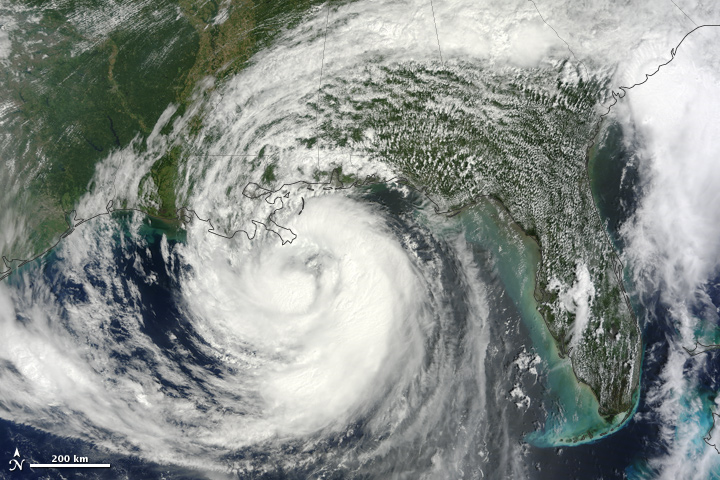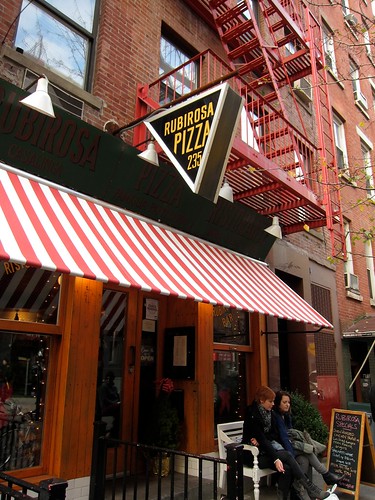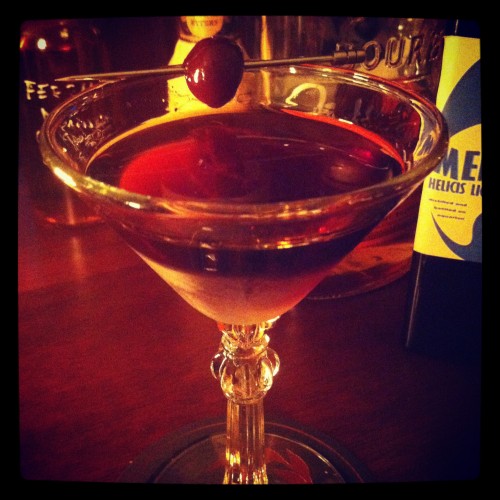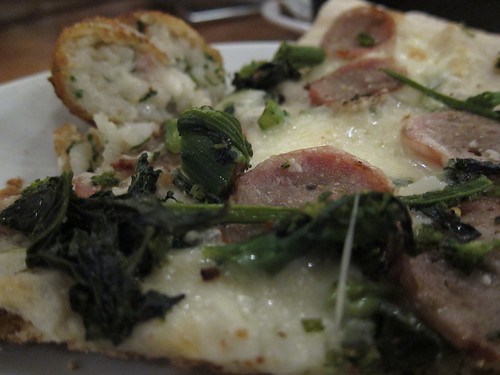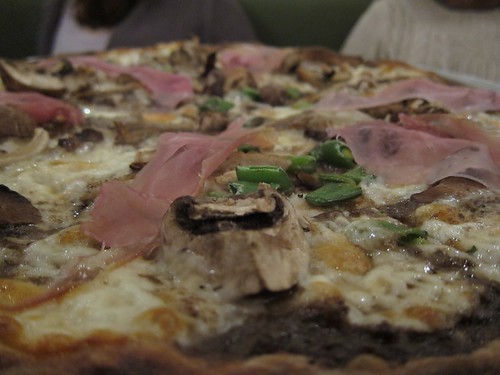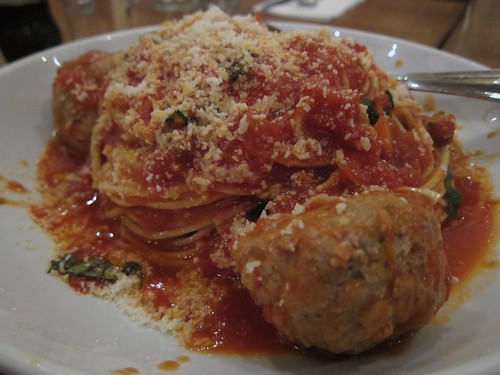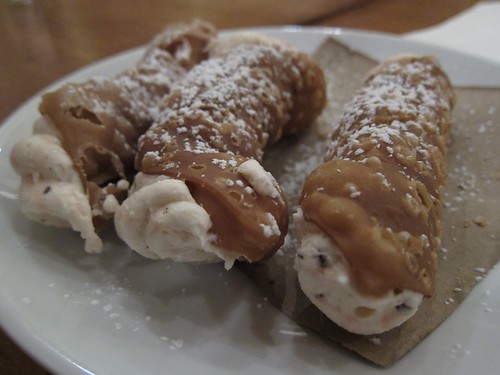Rumours of my disappearance due to abduction by aliens are highly exaggerated. Apparently for a while I slipped into the nascent definition of the term “cocktail blogger” as offered by my pal Jake Parrott, who describes a cocktail blogger as “someone who does not write about cocktails on the Internets.” Or something like that.
And no, I don’t write solely about cocktails on the Internets, but it’s true that I haven’t been writing about anything lately. Fortunately it’s not a case of mojo-loss-in-its-entirety, but I most certainly think that this ol’ weblog was in dire need of a jumpstart. Such a jumpstart, in the form of an epic visit to one of our favorite bars, came last week, as if one had attached jumper cables to … um. Well, before I come up with an entry for the World’s Worst Metaphor Contest, I’ll stop making metaphors and start talking about drinking.
It’d be hard to pick just one bar to designate as our “local,” as there are three that we visit most frequently, but if I had to pick one it’d probably be Big Bar at The Alcove Café in the Los Feliz neighborhood of Los Angeles. (The other two would be Bar & Kitchen at the O Hotel downtown, and Bar 1886 at The Raymond in Pasadena.) Not walkable, sadly, but being less than 15 minutes from the house and the closest of the three makes it Close Enough. We love the mightily talented bar staff, the food from The Alcove is terrific, the bar is open and sunny, and as much as we like hanging at the bar with all the bartenders there’s a lovely patio to enjoy the outdoors as well.
Last Thursday we got together with a bunch of friends to try the brand-new midsummer cocktail menu at Big Bar — every single one. Yes, of course, we shared; eleven cocktails in one evening would be a bit much, don’t you think? In response to one friend who responded to my Instagram posts with “Good lord, you must be totally wasted by now,” we took a few sips and passed them along. It was a whirlwind of different spirits and flavors and styles, and all mighty, mighty good.
Mixicologist of tipicular fixins Dan Long took us through the through the menu, and began, as one does, at the beginning:
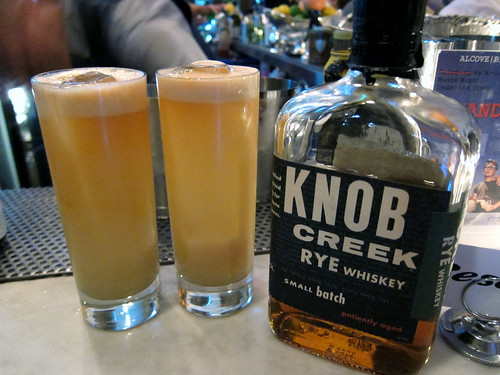
The Thorn In My Side featured a new spirit that I’d been itching to try — Knob Creek Rye. I’ve been a fan of their Bourbon, which comes in at a robust 100 proof. The rye is just as robust in the proof department, and tasting it on its own was worth the wait. Beautiful rye grain spice, lovely notes from the oak, a broad range of rye spice of the brown-baking-spices variety, with cinnamon on the forefront, plus some fruitiness on the palate (stone fruits) and a waft of vanilla. Not nearly as hot as you’d expect at 100 proof, smooth and lovely and spicy and mmm.
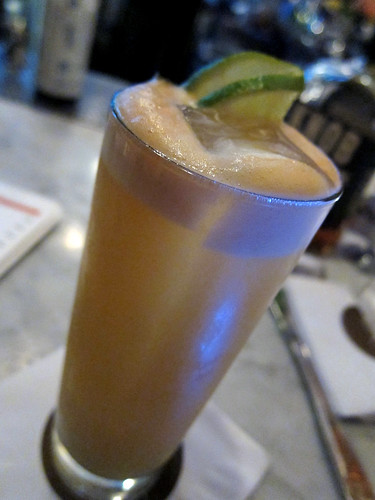
Dan used this in a tall drink that reminded me of a buck but wasn’t quite a buck — there was fresh ginger rather than ginger ale, smoothed out and sweetened by bianco vermouth (Martini & Rossi in this case), and the fizz came not from ginger ale but from Blackthorn cider. Dan said he had bucks in mind when concocting this recipe but wanted to go in a different direction. I liked that direction a lot — spicy and refreshing.

The next menu item said Gin and Tonic Cocktail, but it wasn’t a gin and tonic. How might you take elements of the standard gin and tonic (a lovely tall drink, and nothing wrong with that at all, oh no) and convert that into a stirred cocktail with no fizz? Beefeater gin to begin, of course — pretty much my go-to gin for a G&T. The quinine that you’d get in a tonic water comes in the form of a quinquina, a style of aperitif wine containing quinine. In this drink Dan used the wonderful Kina l’Avion d’Or from the endlessly interesting Tempus Fugit Spirits. (“Kina” is short for quinquina, and the rest of the name translates as “The Golden Aeroplane.”) The bitter bite comes from cinchona bark, source of quinine, plus wormwood as in vermouth, with lovely citrus notes from orange peel and other botanicals. The flavor profile is like “quince and marmalade,” as described by its makers; I’d go right along with that. Despite the bitter components it’s got a nice sweetness to it and is fantastic on its own over ice. In cocktails it’s amazing, and works well where you might use Lillet Blanc, such as in a Corpse Reviver No. 2 or 20th Century Cocktail. If we’re going to have a gin and tonic fresh lime is called for, of course. More citrusy aromatic complexity comes from the marvelous Bergamot Bitters made by Miracle Mile Bitters Co. right here in L.A. (if you’re a fan of tea, Earl Grey, hot, you’ll want these bitters in your collection), and the drink is finished with a spritz of kaffir lime tincture on top.
Creative and delightful. This was one of my favorites on the menu.

Ah, the classic Picon Punch! After a visit to Bakersfield, the unlikely home of a number of Basque restaurants (Picon Punch, made with the now-defunct Amer Picon being the signature drink of Basque folks), Dan wanted to put Picon Punch on the new menu. Two complications arose: 1) classic Amer Picon isn’t even made anymore, and what remains — two low-proof descendent varieties called Picon Bière (for mixing with beer) and Picon Club (for mixing with wine) aren’t available in the United States and aren’t all that great, and 2) Torani Amer, the quite excellent California-made substitute for Amer Picon, invented primarily for use in Picon Punches to satisfy the local Basque-descended folks’ demand, isn’t stocked at the bar.
Dan decided to go a different direction, using the Italian Amaro Montenegro to provide the orange and bitter base for the drink. It’s quite different from the old-style Picon Punch; Montenegro is a gentler amaro and the bitter orange flavor is far more subdued. It has a broader range of herbal notes than contemporary Picon or Torani Amer, which gives this drink a complex and interesting profile.
The classic Picon Punch would typically include a small float of Cognac on top, but Big Bar incorporates it into the drink, and not just any garden-variety Cognac either. Pierre Ferrand, one of my favorite Cognac producers, recently introduced Ferrand 1840, a Cognac made in the style of “three-star” Cognacs of the early 1800s, before the phylloxera epidemic nearly destroyed the wine and brandy grape crops in France in the 1870s-1880s. Bottled at 90 proof, higher than most Cognacs, it’s got a “punchier” profile that makes it ideal for mixing, and it’ll stand up to other ingredients and assert its flavor more readily.
This was a really nice variation. I’d be curious to try it with Amaro Ramazzotti and Amaro CioCiaro too.
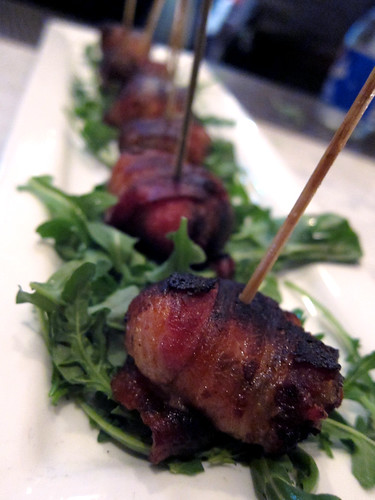
Oh yeah, we had some food too. One simply can’t go wrong with Bacon-Wrapped Dates Stuffed with Goat Cheese, can one? (No, one can’t.) I don’t need to tell you how good this was. One of the more astonishing dishes was something I wouldn’t ordinarily touch — tempeh. I’m still not entirely sure what it is — some soy product that vegans eat, and something I once tried in a vegan household and politely nodded while inwardly recoiling. It’s all in the preparation, however, and when you take French-fry-sized pieces of tempeh, toss them in Buffalo wing sauce, batter and deep-fry them and serve them waith a herbed ranch dipping sauce … well, again, it’s hard to go wrong. I still find the texture of tempeh to be odd, but these were really good, and if you’re in the mood for something vegan yet with some protein in it, this would be your appetizer of choice.
We also tried their new “fish sticks” — thin strips of fresh fish (I forgot what kind, d’oh) lightly battered and perfectly fried, crisp and not at all greasy, along with sweet potato fries. If you’re the kind who enjoys classic fish and chips but feels bloated after the typical pub serving in which you have a piece of fried fish the size of a rolled-up newspaper (and which would leave massive grease stains on an actual piece of newspaper), you can enjoy this very much and still be able to take a deep breath afterward. There was also a plate of the beloved carnitas sliders which disappeared faster than you would in the middle of a shark feeding frenzy. That was the case with all the dishes other than the dates, hence the lack of photos. Quite understandable.
Okay, back to drinking!
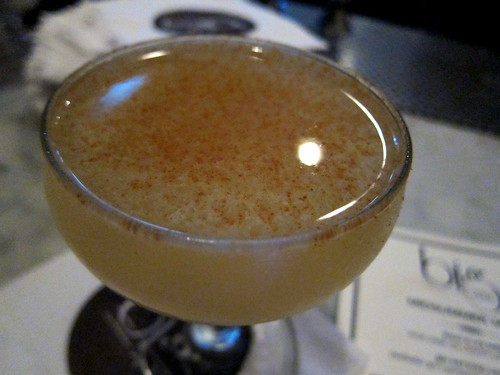
This was the contender for Our Favorite Cocktail of the Evening (although we enjoyed them all and two others tied) — The Most Interesting Cocktail In The World, the brainchild of Big Bar bartender Matt Schaefer. Why is it the most interesting cocktail in the world? I’ll just recite the ingredients: Del Maguey Mezcal Vida. Fresh lime juice. Cinnamon syrup. Miracle Mile Chocolate-Chili Bitters. A dusting of cayenne on top.
Agave. Smoke. Spice. Sourness, in the unique way lime makes a cocktail exotic. Chocolate. Heat. It all combines into something greater than the sum of its parts. You marvel at the way all these elements play with one another. You say “Wow!” and smile. That, my friends, is an interesting and delightful cocktail. Go have one soon.
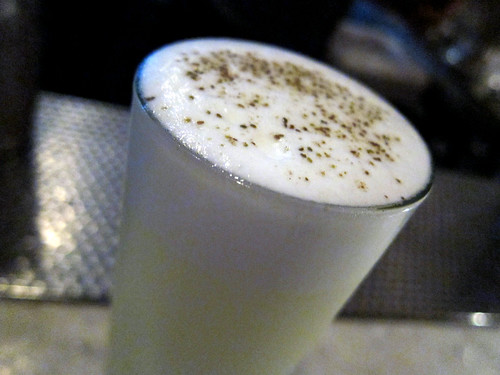
In the Selero Gin Fizz Dan said he was going for “the perfect brunch drink,” and this fills that bill exactly. The classic silver gin fizz — gin, citrus, sugar, egg white, soda — here has some intriguing additions. Plymouth is the gin, natch. The citrus shifts from lemon to lime — again, that exotic lime flavor (as much as I love lemon, I find lime so much more exotic; that’s just the word for it for me). Instead of sugar or simple syrup … green Chartreuse. Sweetness yes, but the oomph of a 110-proof liqueur and nearly endless herbal complexity. The key, killer ingredient? Celery.
Not the celery spear you see sticking out of your Bloody Mary which far too many people discard, not even some of the various brands of celery bitters that have arisen during the cocktail Renaissance (Bitter Truth, Scrappy’s). The “secret ingredient” that they’re happy to share with you is Bittermens Orchard Street Celery Shrub — not a bitters per se, but a blend of brine, celery and other flavors with a vinegar base, reminsicent of Dr. Brown’s Cel-Ray Soda, a beloved New York staple (aka, “The Jewish Champagne”). The final aromatic touch is a sprinkle of celery seed on the foam on top of the drink. You get it on the palate and in the nose; that combination of senses not only makes the celery stand up to the herbal blast that is green Chartreuse but has them dance together beautifully. I had no idea how well celery and Chartreuse went together until I tasted this drink. Just marvelous, and the perfect fizz for a Saturday or Sunday morning before you start your breakfast or brunch.
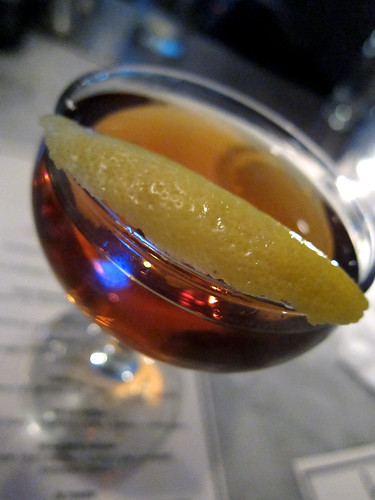
The Belanda Cocktail was another surprise — this one’s just mixed in the glass, with no ice, stirring or shaking. It’s in the style of a type of 19th Century classic called a scaffa, in which the ingredients were mixed in a glass with no ice. My favorite recent example of this is Bobby Heugel’s signature drink from his bar Anvil Bar & Refuge in Houston, called the Brave.
Dan wanted this one chilled, though; the flavors weren’t working for him at room tempterature, but stirring with ice drew the flavors too far apart. His solution — refrigerate the ingredients, then mix. Perfect. The Bols Barrel-Aged Genever, apricot liqueur and East India sherry are kept refrigerated for this drink, combined in the glass and dashed with what the bar calls “improved bitters” — a combination of 1 part Angostura bitters, 1 part maraschino and 1/2 part absinthe. Dan was inspired to use this blend after reading about it in gaz regan‘s latest book. This was unusual and wonderful; I love that barrel-aged genever!
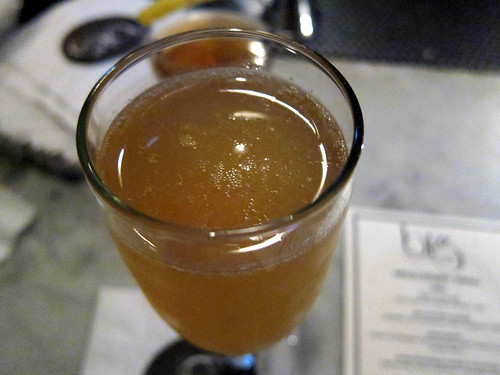
Next came another that seems ideal for mornings and brunch, the Chaton de Mer — Sailor Jerry spiced rum, St. Germain elderflower liqueur, lemon, grapefruit and topped with sparkling wine. The spiced rum and St. Germain work unsurprisingly well together.
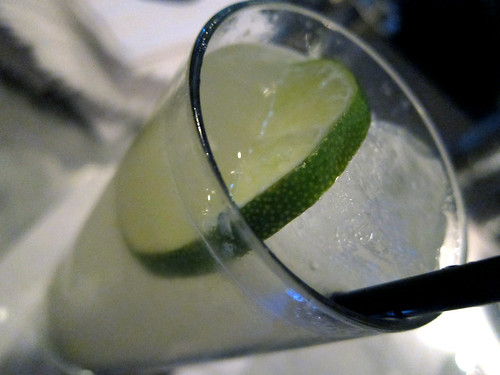
This one Dan described as “the perfect patio sipper,” the Sal Paradise (named for the protagonist of Jack Kerouac’s On the Road). Oro Torontel Pisco, grapefruit, lime, honey syrup, Miracle Mile Sour Cherry Bitters and tonic. Oro is a very interesting pisco producer; in addition to an acholado-style pisco blended from several different grapes, a fairly typical style, they also produce piscos made from the individual varietals. The Torontel grape produces gorgeously floral and aromatic pisco, perfect in this combination of ingredients, and the kicker is the sour cherry bitters. Next time we sit outside this is the one I’m ordering first.
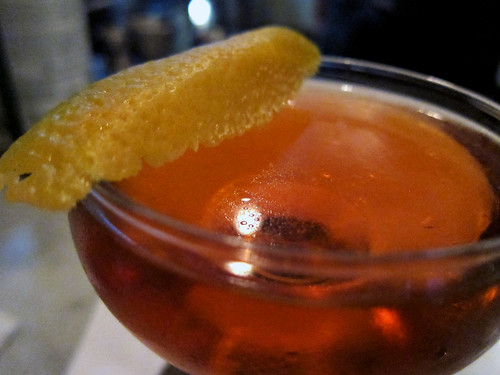
There’s one classic on the new menu, and I was glad to see it was an old favorite, the La Rosita. Tequila, sweet and dry vermouths, Campari and Angostura. The recipe is at the above link if you’d like to try this one at home; we frequently do!
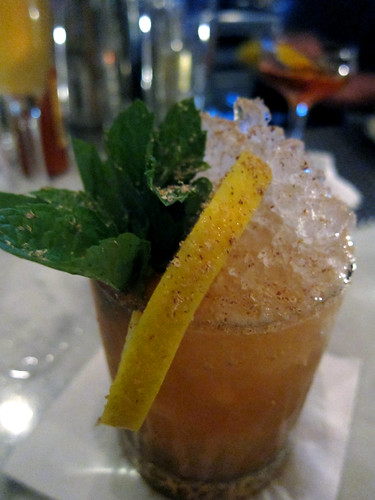
There had to be at least one Tiki drink on the menu, and this one is a powerhouse. The Jet Stream is Big Bar’s take on the Navy Grog, once upon a time my favorite and most oft-ordered tiki drink. (Longtime L.A. denizens might remember the late, lamented House of Lee in Pacific Palisades. They served the same Americanized Chinese food as they had since opening in 1950, but had a marvelous tiki bar with all the classics like Zombies, Scorpions, Fog Cutters and Navy Grog. I miss them.) This one combines THREE cane spirits — Zaya rum, a gorgeously sweet 12-year-old rum from Trinidad; El Dorado 12 year, a Demerara rum from Guyana that’s one of my favorites; and the 2-year barrel-aged expression of Novo Fogo cachaça. A thwap of bitterness comes from some Campari (reminding me fondly of the Bitter Mai Tai), with the sweet and sour elements brought in by a special house blend they call “LGH Fuel” — a mixture of fresh lime, grapefruit and honey.
This one’ll knock you on your butt — gently, and with love. Boy, is it good. I love the blending of rums, a tiki staple, and the complexity you get here from those two rums along with a barrel-aged cachaça is terrific, and tempts you to schlurp it down dangerously quickly. (Take your time; it’s worth it.) Bravo on this one, y’all … another of our very favorites.

Finishing up the menu is St. Anne’s Helper, an example of my beloved “brown, bitter and stirred” — the Manhattan variations so close to my heart. This one’s based on a staple of our home bar, Eagle Rare 10-year Bourbon (which we buy in 1.5 liter bottles), with Carpano Antica as the vermouth, Miracle Mile’s miraculous Forbidden Bitters as the aromatic bitter, and the addition of a nice dose of digestivo, Amaro Meletti (caramelly and cinnamony with floral notes of violets and a bit of saffron). The name was inspired by a stroll Dan took through the French Quarter in New Orleans, where St. Ann(e) appears on everything from street names to churches to hotels to the Society of St. Anne Marching Club on Mardi Gras day. I think she’d like this one as much as I did.
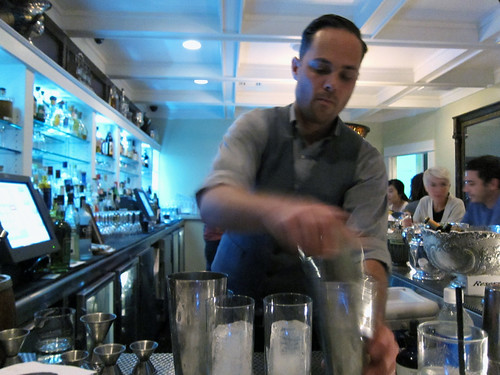
It was an epic evening, and one in which we walked out under our own power, thanks to the virtues of sharing! Thanks to Wesly, Louis, Daniel, Fiona and Caroline for sharing, and thanks a million to our pals Dan Long and Eugene Lee for their hospitality, and for their talent running the program at Big Bar, and to general manager Sean Loeffel as well.
Big Bar’s like a second home to us — go there and you’ll see why.

